Physical Address
304 North Cardinal St.
Dorchester Center, MA 02124
The authors would like to acknowledge and thank Dr. Anand K. Mishra for contributions to the previous edition of this chapter.
The modern thyroid or endocrine surgeon should have a complete understanding of the embryonic development of the thyroid and parathyroid glands as well as knowledge of the possible congenital abnormalities associated with these glands, because they may affect the completeness of surgery and cause complications during surgery. The surgeon comes to a more intuitive understanding of surgical anatomy through the comprehensive appreciation of the underlying formative embryology.
The thyroid gland has a double origin: the primitive pharynx and the neural crest ( Figure 2.1 ). The primitive pharynx is responsible for the origin of medial thyroid anlage, whereas the lateral thyroid anlage originates from the neural crest, the source of parafollicular cells, or C cells, that secrete calcitonin. These cells derive from the ultimobranchial bodies. An understanding of the ultimobranchial origin of C cells has come from the studies of patients with DiGeorge syndrome, which causes a complete or partial absence of the caudal pharyngeal complex. Less than one-third of these patients have C cells within their thyroid.
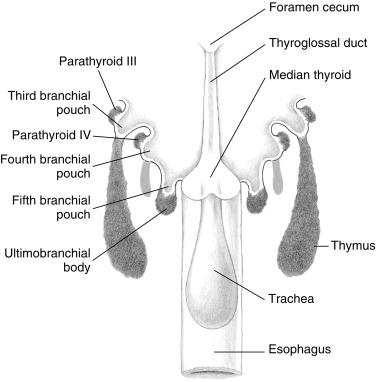
The primitive pharynx is the origin of the main central portion of the thyroid which appears during the second and third week of fetal life ( Figure 2.2 ). This medial thyroid anlage arises on the ventral pharyngeal wall (the tuberculum impar ) at the level of the second branchial arch, appearing as a single or paired diverticulum. The median anlage forms the bulk of the thyroid gland. Division of the gland into lateral lobes, if not present from the beginning, occurs so early that it is impossible to determine whether the thyroid arises singly or as a paired organ. The median stalk usually has a lumen (the thyroglossal duct) that does not extend into lateral lobes. This diverticulum follows the primitive heart as it descends caudally. It becomes a solid cord of cells that will form the follicular elements. Then it breaks in two: the proximal part retracts and disappears; however, its pharyngeal connection results in a permanent pit, the foramen cecum at the apex of the V-shaped sulcus terminalis on the dorsum of the tongue. Early during the fifth week, the attenuated duct loses its lumen and shortly afterward breaks into fragments. The caudal end develops as bilobed encapsulated thyroid gland proper, reaches its final adult orthotopic position at the level of the developing trachea by the seventh week, and undergoes histologic differentiation into the typical follicles during weeks 10 and 11, which acquire colloid by the third month.
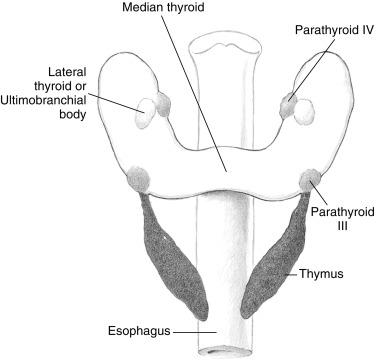
Subsequent follicle formation takes place by the budding or division of primary follicles. Follicle formation is preceded by the appearance of an intracellular periodic acid–Schiff (PAS)-positive material. Bierring and Shepard have described intracellular canaliculi with microvilli, which open at the apex and are in contact with similar structures in adjacent cells. These spaces become confluent and form the lumen of the developing follicles. Desmosomes connect the cells to keep the follicular contents from escaping. During the 11th and 12th weeks, all stages of follicle formation may be observed simultaneously. The greatest increase in follicle number takes place during the fourth month; colloid appears in the follicles during the 11th week. LiVolsi divided the histologic differentiation of the human fetal thyroid into three stages: precolloid (7 to 13 weeks); colloid (13 to 14 weeks); and follicular (after 14 weeks).
The lateral thyroid anlage develops from proliferation of pharyngeal endoderm. The ventral portion of the fourth pharyngeal pouch becomes attached to the posterior surface of the thyroid during the fifth week and contributes up to 30% of the thyroid weight. The right and left lobes of the thyroid grow caudally with the growth of the fetus, taking up their final position at either side of the second to fourth tracheal rings. The line of normal embryologic thyroid descent of the medial anlagen is called a thyroglossal tract. The determinants of fusion of the median and lateral anlages are unknown. The site of the fusion of these two structures is stated to occur at the tubercle of Zuckerkandl (TZ). Sugiyama speculated that the migration of the ultimobranchial body controls the growth of median anlage. The C cells from the ultimobranchial body of the lateral anlagen are not scattered throughout the entire thyroid but are restricted to a zone deep within the middle to upper thirds of the lateral lobes along a hypothetical central lobar axis. The extreme upper and lower poles, as well as the isthmic regions, are generally devoid of C cells.
Correlative studies of tissue calcitonin immunoreactivity and C-cell distribution have shown that the highest concentrations of the hormones are found in sections corresponding to the junctions of the upper and middle third of the lateral lobes paralleling the distribution of medullary carcinomas typically arising in the upper and middle third of the lateral thyroid lobes. This has the following two practical implications for the surgical management of patients with medullary thyroid carcinomas:
Subtotal or even near total resections, leaving a small posterior remnant of thyroid tissue, should never be done.
Because lymphatic drainage of the superior poles of the lobes may flow directly into the lateral neck area, lateral neck nodes should be systematically explored, even if the central neck nodes are not involved.
The thyroglossal duct is an epithelial tube that connects the gland and the foramen cecum (see Chapter 5 , Thyroglossal Duct Cysts and Ectopic Thyroid Tissue). Early during the fifth week, the attenuated duct loses its lumen and shortly afterward breaks into fragments. During the fifth through the seventh weeks of gestation, the hyoid bone is formed by condensation of mesoderm with subsequent chondrification from the second and third branchial arches; this grows from behind forward, dividing the thyroglossal tract into suprahyoid and infrahyoid portions. The attenuated thyroglossal duct tract usually atrophies and disappears by the end of the eighth week. The tract may persist as a fibrous cord or a minute epithelial tube.
A number of transcription factors involved in thyroid descent and development have been identified. TTF-1 appears at the earliest stages of thyroid development and regulates expression of thyroperoxidase and thyroglobulin. Disruption of this gene in mice results in thyroid agenesis. Pax-8 , which acts similarly to TTF-1, is expressed in embryonic thyroid during descent, and heterogeneous mutations are associated with thyroid hemiagenesis. TTF-2 regulates the TTF-1 and Pax-8 genes, and its alteration is associated with thyroid dysgenesis. HoxA3 regulates diverse embryonic processes. Disruption of murine HoxA3 results in thyroid hypoplasia, whereas combined disruption with HoxB3 or HoxD3 results in failure of fusion of the ultimobranchial body with the thyroid. All of these genetic abnormalities appear to result in impaired thyroid descent or development.
Various anomalies of the development of the thyroid gland involving the median or the lateral anlage (or both) have been described ( Table 2.1 ) (see Chapter 5 , Thyroglossal Duct Cysts and Ectopic Thyroid Tissue, and Chapter 9 , Reoperation for Benign Disease). Developmental variations involving the thyroid can be categorized under the following groups:
Anomalies of median thyroid anlage
Thyroid ectopias: thyroid rests, lingual thyroid, midline ectopic thyroid
Thyroglossal duct cysts (TDCs) and fistulae
Pyramidal lobe
Agenesis/hemiagenesis
Anomalies of lateral thyroid anlage
Tubercle of Zuckerkandl
Anomalies of abnormal/continued descent
| Both Median and Lateral Anlages | Median Anlage | Lateral Anlage | Neither Anlage |
|---|---|---|---|
|
|
|
|
Although ectopic thyroid tissue can be found between the foramen cecum and the normal position of the thyroid gland, the two most common sites of undescended thyroid glands are the lingual thyroid (90%) and the anterior neck (10%) ( Figure 2.3, A and B ). Most of them are detected during childhood and are often associated with hypothyroidism. Under the influence of continued thyroid-stimulating hormone (TSH) stimulation, they may enlarge and produce local symptoms. The ectopic thyroid tissue in the anterior neck may present as a midline mass and may be misdiagnosed as a thyroglossal cyst. It is important to differentiate ectopic thyroid tissue from the TDC because it frequently represents the only source of thyroid tissue.
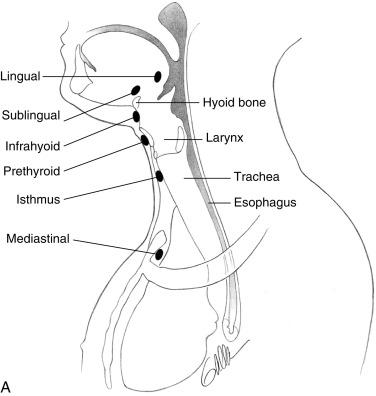
Thyroid rests are isolated rests of normal thyroid tissue lying below the lower pole of the thyroid within the line of the thyrothymic tract, or even within the upper anterior mediastinum (see Chapter 6 , Surgery of Cervical and Substernal Goiter, and Chapter 9 , Reoperation for Benign Disease). They may also have an extension or prolongation of the thyroid tissue attached to the lower pole of the thyroid by a narrow pedicle or even just a fibrovascular band. These rests are presumably an extension of the normal embryologic descent of the thyroid after separation into right and left lobes and are present in over 50% of patients ( Figure 2.3, C ). Awareness of variable projections or extensions of thyroid parenchyma is critical to ensure complete removal of all thyroid tissue. Thyroid rests can be located within the anterior mediastinum, and they may sometimes be mistaken for small lymph nodes or even parathyroid glands. The development of nodular change within such a rest might be recognized as a thyroid nodule completely separate from and caudal to the lower pole of the thyroid gland. If such a nodule lies even further caudal, within the anterior mediastinum, following the descent of the heart and the great vessels, it might well give rise to the “isolated” mediastinal or “primary” intrathoracic goiter (see Chapter 6 , Surgery of Cervical and Substernal Goiter). The blood supply for these intrathoracic rests is usually from intrathoracic vessels. This explains why primary intrathoracic goiters may require a thoracic surgical approach (i.e., sternotomy) to achieve vascular control.
Sackett et al. have suggested a classification for thyroid rests in relation to the thyroid gland (see Figure 2.3, C ).
Grade I. Thyroid rests consist of a protrusion of thyroid tissue arising from the inferior aspect of the thyroid gland in the region of the thyrothymic ligament, which is recognizably distinct from the line of the lower border of the thyroid lobe ( Figure 2.3, E ).
Grade II. Thyroid rests include thyroid tissue lying within the thyrothymic tract and attached to the thyroid proper only by a narrow pedicle of thyroid tissue.
Grade III. Thyroid rests are similar to grade II but are attached to the thyroid gland only by a fibrovascular core ( Figure 2.3, F ).
Grade IV. Thyroid rests have no connection to the thyroid gland.
The thyroid rests sometimes lead to intraoperative difficulty in mobilizing the inferior thyroid pole because of its attachment to the thyrothymic ligament. A parathyroid gland is occasionally found in close proximity to a thyroid rest and adjacent thyrothymic ligament. The inferior parathyroid gland migrates caudally with the thymus gland.
Thyroid rests have clinical significance because they may be the source of recurrent goiters and may lead to compressive symptoms later (see Chapter 9 , Reoperation for Benign Disease). They may also be a source of radioactive iodine uptake after total thyroidectomy done for carcinoma. Hence the knowledge of thyroid test anatomy is important to ensure complete removal of all gross thyroid tissue during total thyroidectomy.
Snook et al., in their retrospective analysis of 3044 total or secondary total thyroidectomies performed for benign multinodular goiter in the previous 25 years, reported 11 recurrences out of which 5 recurrences were in the thyrothymic tract. They concluded that the failure to remove embryologic remnants such as thyrothymic rests during total thyroidectomy is a cause of recurrence.
Failure of the descent of the thyroid gland anlage early in the course of embryogenesis results in a lingual thyroid near the foramen cecum (see Chapter 5 , Thyroglossal Duct Cysts and Ectopic Thyroid Tissue). The applied importance of lingual thyroid is as follows:
In the majority of cases, the lingual thyroid may be the only functioning thyroid tissue.
An enlarging lingual thyroid located at the base of the tongue ( Figure 2.4, A ) may present with symptoms of dysphagia, upper airway obstruction, or even hemorrhage.
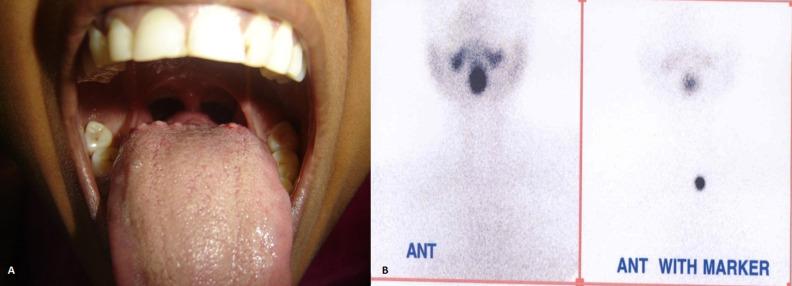
Although rare (43 reported cases), malignant transformation of the lingual thyroid tissue may occur.
The diagnosis of a lingual thyroid may be confirmed by a radioiodine scan ( Figure 2.4, B ), which would typically reveal an increased uptake focus at the base of the tongue with no apparent activity in the normal pretracheal location of the thyroid gland in the neck. Regarding treatment, in children or young adults who are euthyroid and whose sole thyroid tissue is the lingual thyroid, no treatment would be necessary. However, more commonly these patients develop obstructive symptoms secondary to hypertrophy of the lingual thyroid because of continuous TSH stimulation as a result of hypothyroidism. In such a situation, thyroxine supplementation or sometimes suppression helps shrink the lingual thyroid, and surgical therapy may not be required. Rarely, in situations of continued growth and obstructive symptoms or hemorrhage, surgical removal of the lingual thyroid may be necessary. Ablative radioiodine therapy is an alternative approach recommended in older patients or patients who are not fit for surgery. The surgical approaches include transoral and external approaches.
Early during the fifth week, the attenuated duct loses its lumen and shortly afterward breaks into fragments (see Chapter 5 , Thyroglossal Duct Cysts and Ectopic Thyroid Tissue). During the fifth through the seventh weeks of gestation, the hyoid bone is formed by condensation of mesoderm with subsequent chondrification from the second and third branchial arches, which as noted previously, grow from behind forward, dividing the thyroglossal duct tract into suprahyoid and infrahyoid portions. The attenuated thyroglossal duct tract usually atrophies and disappears by the end of the eighth week. This tract may persist as a fibrous cord or a minute epithelial tube, and this persisting tube/duct/cord is called a thyroglossal duct, which connects the gland and the foramen cecum. The thyroid gland may reach its normal position, leaving rests of cells anywhere along this embryonic path, and give rise to postnatal development of cysts; or it may leave rests at any level along the midline developmental pathway (sublingual, prelaryngeal, or rarely, the suprasternal). A TDC does not have a primary external opening, which is characteristic of some branchial cleft cysts, as the embryologic course of the tract never reaches the surface of the neck.
TDCs are the most common congenital cervical abnormalities, three times more common than branchial cleft remnants. Cysts usually present as a painless, asymptomatic midline swelling below the hyoid bone ( Figure 2.5 ) and may be observed at any age. TDCs are present at birth in approximately 25% of cases, most are noted during childhood, and the final third become apparent after age 30. The gender incidence is equal. They can be found anywhere in the midline, from the submental region to the suprasternal notch, but are most commonly located halfway between these extremes, near the hyoid bone. Ward et al. noted that 80% were juxtaposed to the hyoid bone (25% located in the submental region), 2% lingual, and 7% in a suprasternal location. Only 1% of TDCs were lateral to the midline. On examination, cysts are round with a smooth surface and are well defined. With swallowing or protrusion of the tongue, they typically rise in the neck as a result of being anchored to the hyoid bone and the muscles of the tongue. They are usually 1 to 2 cm in diameter, slightly mobile, and nontender unless there is a superimposed infection. Oral bacteria may be transmitted through the foramen cecum. Thyroglossal duct sinuses are secondary to infection of the cysts as a result of spontaneous or surgical drainage and are associated with some degree of low-grade inflammation of the surrounding skin. The cutaneous opening is usually 1 to 3 mm in diameter and may intermittently express small droplets of thin mucoid fluid, which is usually clear or yellowish.
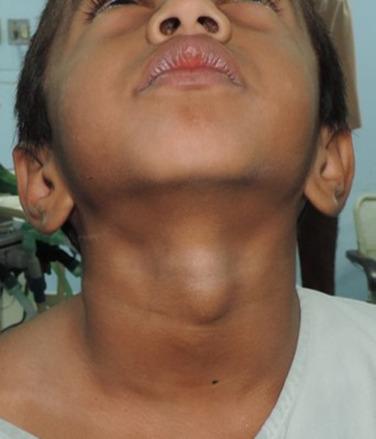
Preoperative thyroid imaging and thyroid function assessment should be done in all patients with TDCs to see the normal thyroid gland. Thyroid scintigraphy can be performed in patients with presumed TDCs to document the presence of a normal thyroid and to exclude the possibility of an ectopic thyroid. Preoperative high-resolution sonography can also identify a normal thyroid gland and exclude ectopic thyroid tissue.
The operation to remove the thyroglossal cyst includes the removal of the cyst with a central portion of the hyoid bone and the epithelium-lined tract, which runs from the cyst to the foramen cecum19 and is called a Sistrunk operation. A Sistrunk operation consists of en bloc cystectomy and central hyoidectomy, with tract excision up to the foramen cecum. In Sistrunk’s original report, 31 TDCs were encountered among 86,000 consecutive thyroid patients examined at Mayo Clinic. Sistrunk emphasized the need to make no attempt at isolating the suprahyoid portion of the duct. “At this point the tract usually passes through the hyoid bone, although it is sometimes found passing above or below it.” The index finger of the surgeon’s hand can be placed in the patient’s mouth and on the foramen cecum to elevate the tongue and to guide excision of the suprahyoid tract. Sistrunk observed that the excision invariably proceeds at a 45-degree angle. Although Sistrunk recommended apposition of the cut edges of the hyoid bone, it is more recently thought to be neither necessary nor wise to attempt to repair the cut ends of the hyoid, especially in a child.
Histologically, a TDC is lined by pseudostratified ciliated columnar epithelium, squamous epithelium, or both. The supporting wall of the cyst consists of fibrous tissue and frequently (20%) contains heterotopic thyroid tissue and accumulations of other chronic inflammatory cells. Approximately 1% of TDCs may undergo neoplastic change, 85% of which are papillary adenocarcinoma. Cases of squamous cell, anaplastic, and Hürthle cell carcinoma in TDCs have been reported. Usually these malignancies are discovered after a Sistrunk procedure. Widström’s criteria for the diagnosis of primary papillary carcinoma arising in a TDC include the following :
Histologic identification of TDC demonstrates that the cyst or duct has an epithelial lining with normal thyroid follicles in the cyst wall.
There is normal thyroid tissue adjacent to the tumor.
Histopathologic examination of the thyroid gland reveals no signs of primary carcinoma.
Become a Clinical Tree membership for Full access and enjoy Unlimited articles
If you are a member. Log in here